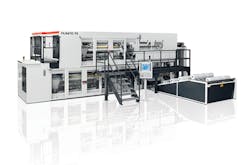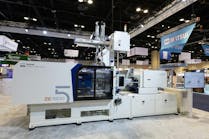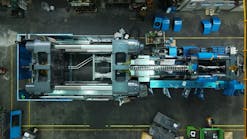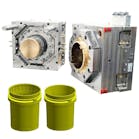Machinery makers are being challenged to address the increasing demands of cast stretch film — getting film thinner and thinner while improving strength and flexibility. New technologies introduced at K 2013 have improved even more.
In general, cast film markets worldwide are healthy, and the cast stretch film market is particularly strong and growing. It's solid in North America, growing at nearly 3 percent annually, while growth is even higher in many emerging economies around the world. Despite the slowdown that's taken place in many of those economies, as well as in many economically mature regions, globalization of manufacturing means that a lot of shipping is going on.
These days much of that shipping takes the form of pallets stacked with cartons or other shapes of packaging traveling by ship, train and truck. Shippers believe all that merchandise should arrive at its destination perfectly intact. Yet recent studies estimate that annual losses due to products damaged in handling and transport cost shippers about $2.6 billion.
That is precisely the problem that rolls of stretch film have been relieving for decades. Everyone involved with goods transport for any length of time has seen the percentage of pallets securely wrapped in transparent film steadily increase. It is still increasing, as is the strength of the film — even as it has gotten thinner and, as a result, more sustainable and economical.
Naturally, it took a parade of significant materials, machinery and processing innovations to make stretch film stronger, thinner, lighter and more sustainable and economical. And just as naturally, with stretch film usage rising, along with market demands for improved performance and lower cost, the development of technology innovations is holding its fast pace.
Clear evidence of that is the variety of technological innovations coming from machine line makers — often in concert with resin suppliers — that are now offering stretch film processors options and tools to improve their products that, as recently as 10 years ago, were unthinkable. Examples: A leading supplier of cast stretch film lines is moving what was a major off-line process to in-line; another longtime maker of cast film lines has developed a totally new, stretch-film-specific winder to spearhead a major push into that market.
Steve Post, VP of cast film at extrusion and converting system supplier Davis-Standard LLC, Pawcatuck, Conn., says about 80 percent of the total cast film market consists of stretch wrap, hygiene film (diaper back sheets, hospital gowns and bed sheets, etc.) and cast polypropylene. Stretch is by far the biggest part, hygiene film is growing and so is cast PP, though almost all in Asia.
Suppliers of stretch film in North America are bullish about a market that's growing at close to a 3 percent annual clip, says Post. And, he points out, it's growing from a relatively large base. Suppliers feel resin prices will drop as natural gas supplies increase. Shipping film made in the U.S. to Europe is well within the realm of possibility.
Post says one familiar trend is continuing in the stretch film market — downgauging. A few decades ago film that was 25 to 30 microns, or around 1 mil thick, was considered thin. Post says his company's lines are now making stretch film as thin as 6 microns in the conventional process and the pre-stretch process, where the film is stretched in-line to make it stiffer and thinner. That's thin for sure, but the real breakthrough here is that the pre-stretching is being done in-line, on a station just before the winder.
Pre-stretch began in Europe about 10 years ago and began to take off about three years ago in North America, where currently it's growing at a rate of more than 15 percent a year. But as Post points out, no one is doing pre-stretching in-line now. It is being done off-line using rewinders. Aiming to change that, Davis-Standard launched its new dsX s-tretch pre-stretch cast film extrusion line at the K 2013 show in Düsseldorf, Germany, and made pre-stretch film in-line on a working line at its German facility.
Fast forward to now, when Post says Davis-Standard has perfected the process of doing pre-stretch in-line. Its first installation takes place this month in Southeast Asia.
"We only had run at a limited speed," he says of last year's K show display. "Now we're running near 1,000 meters per minute. We've run at speeds faster than the industry."
The dsX s-tretch line is 2 meters wide so it has a lower footprint but allows for growth. Because it uses pre-engineered technology, it can be available in as little as six months in five- and seven-layer options. In the future, the line will be offered with environmentally friendly coreless technology so both material and disposable costs will be reduced.
Some benefits of making pre-stretched stretch film in-line vs. off-line are obvious: no production floor space taken by rewinders, less movement of rolls across the production floor, reduced labor and a lot of time saved. Fans of lean manufacturing will love it.
But Post says there's another benefit that trumps all the others.
Most cast film processes are limited by line speed: how fast you can cool the film, or pin the web to the chill roll out of the die. As film keeps getting thinner, if line speed doesn't increase the net output of the line drops. Most cast stretch film, both hand and machine rolls, is sold by the pound. Lower machine output is a problem for the processor. Post says that with in-line pre-stretch, the processor can make film from the die at a slower speed — conventional process limits are 1,600 to 1,800 feet per minute — but if the film is stretched three times in-line the result can be an effective line speed greater than 3,000 feet per minute.
One additional benefit of pre-stretching worth mentioning: It results in a stiffer film, and that means better load retention and much lower load movement on stretch-wrapped pallets. Since the pallets and their contents are better supported during the transportation cycle, there should be less waste caused by damaged goods and more smiling shippers.
Though most stretch wrap film is made of 2-4 melt index linear low density polyethylene, some metallocene-catalyst materials may be used to increase puncture resistance or to give better properties to the tack layer. Polypropylene may be used to make the film stiffer overall. But when any of these are used in a film structure they are 5 to 10 percent of the content, at most. Linear low is still the go-to material, and there is one technological development in cast film that may help it keep that title.
Regarding another trend in cast film technology: Post says that though most cast stretch film uses five- or seven-layer structures, there has been a lot of discussion recently about microlayer and nanolayer structures. Extrusion die makers Nordson Extrusion Dies Industries LLC (EDI) and Cloeren Inc. both supply feed blocks that can make film structures in the 20- to 35-layer range.
MINDING THE WINDER
During last year's K show, extrusion, printing and conversion systems supplier Windmöeller & Hoelscher Corp. was demonstrating a cast stretch film line at the nearby headquarters in Lengerich. W&H is well known as a supplier of cast film lines and was using the occasion to show its new technology for stretch film.
W&H's Nick Nigro was at the demo; he is the company's U.S.-based product manager for cast film, and his discussion of this new line is focused at one end of it, the winder.
Nigro says the winder on the line, the Filmatic PS (power stretch) is totally new, designed starting with blank paper and dedicated to cast stretch film from start to finish.
"Unless you have a terrific winder you will have issues running stretch film, especially at high output rates," he says. Anything less than great winding will usually result in low film quality, mainly roll quality and tension issues but other errors as well.
"We had the chance to engineer out all the typical problems seen in running cast stretch film on existing equipment. We had the benefit of starting with a clean sheet of paper and our engineers knowing what was out there and what was needed."
The result includes a mechanical arrangement where the shaft construction and clamping mechanism all work as one unit. Engineers carefully crafted the shaft length, shaft construction and mounting and support mechanism. Three winding shafts per turret provide extremely short web turning as well as cycle times because of fully automatic, simultaneous shaft loading and unloading. The tension control within the winder was precisely engineered with multiple zones throughout.
"Once the complete film enters the winder, the web paths are exactly the same from shaft to shaft," Nigro says.
This particular machine has an innovative feature that also optimizes and maintains the winding hardness during winding.
The big issue is precision, and that's because cast stretch film is highly extensible. Any small deviation can impact edge quality and how much stress goes into the film. To put up a good roll of cast stretch film you need to relieve the stresses in the film as much as possible before the film goes on the roll, and then have a winder that will not introduce any new tensions into the roll of film. Nigro says W&H now has that kind of winder specifically for stretch film, and it has been accepted by the industry. A few lines already are sold, including in North America.
As they're getting feedback, W&H will continue to upgrade and modify the equipment. Since the K Show, the company has made multiple control enhancements. The demands on stretch film performance never have been greater where, for example, it can be as thin as 6 microns with load retention, clarity and 300 percent stretch capacity.
"We're always looking to improve," Nigro says.
As a veteran of the film extrusion business, Nigro sees the industry at a point where there has never been so many opportunities. He says downgauging seems continual and there are many newer resins offering the processor choices that were never there before. And then he uses the term "extraordinary film structures." Of course he's talking about the microlayer and nanolayer technology, but what excites him more than the technology itself is the options it gives the processor.
What with the resin choices and the feed block technology, and let's not forget the high precision of the cast film line, a processor can really create a film that does exactly what it is supposed to do. Nigro claims W&H probably has more nanolayer lines working than any other supplier, all with Cloeren feed blocks, but he stresses that simply putting a nano feed block on a line may not deliver any noticeable results. On the other hand, by designing a film structure with functional layers and selecting resins based on their barrier, mechanical or other properties needed, the benefits can be huge.
This approach isn't new, says Nigro. Successful production is always due to a combination of all elements in a process. W&H makes sure it understands what the processor is trying to do, the trends in the market segment, consumer demands, regional differences, anything that could be an influence. They look at a trend and then see what materials-machine-process combination will let the processor capitalize on that trend.
"Just doing your homework," he says, "you find things to do that were impossible a few years ago."
Rob Neilley, senior correspondent






